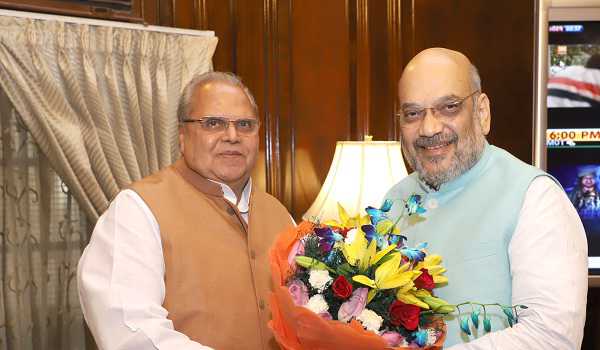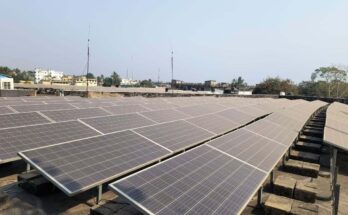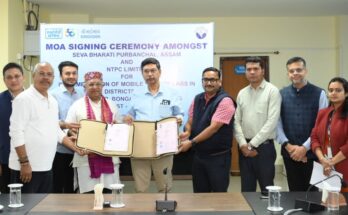By Nirendra Dev
There are whispers in corridors of power that if things work out according to plans, there could be a chief minister from Jammu region for the first time in trouble-torn state of Jammu and Kashmir.
Predictably, National Conference leader Omar Abdullah and PDP chief Mehbooba Mufti have said forced delimitation is an obvious attempt to inflict another emotional partition of the state.
The newly-installed Modi government’s reported move for carrying out a ‘delimitation exercise’ for assembly segments in Jammu and Kashmir could ‘increase’ the number of elected legislators in the assembly from Dogra Hindu dominated Jammu region and such a step has endorsement from the RSS and BJP.
The 2011 census had revealed that the total population of Jammu Division was 5,378,538, of which Dogra community, making about 63 per cent, was the dominant group.
According to state-level BJP leader Ashok Kaul, there is nothing unusual in the home ministry’s reported move especially after the Modi government had been voted to power with a ‘renewed and enhanced mandate’.
The demand for delimitation was also listed in the “agenda of alliance with the PDP” in 2015 as well. BJP sources in Delhi read it well that once the delimitation of assembly constituency is carried out, there will be ‘equity’ in terms of number of seats to be reserved for Schedules Castes in Jammu region and there will be increase in the representation of Jammu in the J&K assembly.
“Once number of legislators increase, this will automatically raise the prospects of the state getting its first chief minister, who need not be from the Kashmir region,” a senior leader said.
The ‘monopoly’ of Kashmir region in sending more legislators to the state assembly as compared to Jammu and Ladakh region too will end, the source suggested.
The delimitation exercise was proposed earlier by the Vajpayee government in 2002 and later in 2007 by Congress chief minister Ghulam Nabi Azad – but in both the cases, the proposal had to be shelved. At present, the Kashmir region in the state has 46 seats, while Jammu region has 37 and Ladakh only four.
For over a decade now, the saffron party has also toyed with the idea of getting 13 seats kept vacant for areas of the state (illegal occupation of Pakistan) should be given to ‘west Pakistan refugees’ who have settled in Jammu.
The RSS and BJP leaders have been believing for quite sometime that getting adequate representation to Jammu region would help resolve ‘many problems’ in the militancy-hit state.
Gauging the mood well, Kaul has said – “We urge state governor Satya Pal Malik to set up a Delimitation Commission to end discrimination with Jammu region. Moreover, it should be carried out before assembly elections”.
On Tuesday, in quite an important development, the Election Commission said that it would consider holding Assembly polls in Jammu and Kashmir later this year.
The commission said it would announce the schedule for assembly elections in the state after the conclusion of the ‘Amarnath Yatra.’
Now, whether carrying out delimitation exercise will be possible by November-December is not clear yet, but reports suggest at his maiden and crucial meeting with Malik and home secretary Rajiv Gauba and others, Union home minister Amit Shah was briefed in detail about many facets of the ground situation in the state.
Shah was also briefed that his party’s state unit has been raising the issue of withdrawal of a 16-year-old freeze on carrying out delimitation exercise in the state. The ban was imposed by the erstwhile Farooq Abdullah government in 2002.
Sources said the new proposed exercise will grant reservation in the legislature to certain communities like Gujjars, Bakerwals, Gaddis and Sippis. These groups were given Scheduled Tribe status in 1991 and form about 11 per cent of the population.
At present Chamb, Domana, Ranbir Singh Pura, Samba, Hiranagar, Chenani and Ramban in Jammu, Kathua and Udhampur district have SC reservation seats for the assembly.
After PDP-BJP regime came to power, in December, 2016, a cabinet sub-committee on implementation of Agenda of Alliance of PDP-BJP government had referred the issue to a high level bureaucratic panel.
But this did not move further.
In 2007, during Ghulam Nabi Azad’s term as chief minister, he had recommended a proposal of 25 per cent all round increase in the number of assembly seats of all three geographical regions but the National Conference had opposed it and PDP-Congress did not have the two-third majority in the assembly to push it either.
According to the 2011 census, Jammu has 25.93 per cent of the area and 42.89 per cent of the population. The much-talked about Kashmir Division has 15.73 per cent of the state’s area and holds 54.93 per cent of the population. Over 95 per cent of them being Kashmiri Muslims.
Ladakh has 58.33 per cent of the area accounting for 2.18 per cent of the population and nearly 40 per cent are Buddhists.
(UNI)




